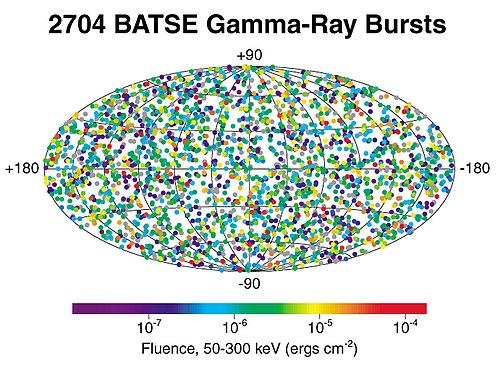General Astronomy/Introduction and Brief History of Gamma-Ray Bursts
Gamma Ray Burst
editGamma-Ray Bursts (GRBs) are bright flashes of highly energetic light, ranging from one keV to many GeV, which last from a few milliseconds to several minutes. They can have a rise times as fast as 10−4s, and exponentially decay. Gamma-ray bursts are detected about once per day from random directions in the celestial sphere. [1] They have luminosities of 4.4 × 1044 W, making them shine hundreds of times brighter than a typical Supernova and are about 1018 times more luminous than our Sun. [2] They can have total energy releases of 1052 ergs or 1045 J. [3] Gamma-Ray Bursts are the brightest objects known in the Universe, many orders of magnitude brighter than any Quasars. [4] They typically originate outside our galaxy in the farthest reaches of the universe.[1]


The mystery of GRB’s started in the 1960s. GRBs were first detected by a group of U.S. military satellites named Vela. The Vela spacecraft were designed to monitor the compliance of the Soviet Union and other nuclear capable states with the 1963 Partial Test Ban Treaty.[1] The original Vela satellites were equipped with six gamma-ray detectors, which looked for sudden bursts of gamma rays, possibly from nuclear weapon detonation.[5]
On July 2, 1967, Vela 4 and Vela 3 detected flashes of gamma radiation that were not characteristic of any known nuclear weapons.[5] Nuclear Bombs produce intense burst of gamma rays for less than 10−6s. The gamma rays then gradually fade as nuclei decay. The gamma ray burst detected in 1967 did not have an intense initial flash or a steady fading.[6] In 1969 the data were analyzed by a Physicist named Ray Klebasabel. Klebasabel found a spike in the data, a dip, a second spike, and a long, gradual tail off. Klebasabel said “One thing that was immediately apparent was that this was not a response to a clandestine nuclear test." His team checked for possible solar flares and supernovae that could be reasonable and found none.[5]
On May 23, 1969 Vela 5 was launched. Vela 5 was more sensitive and had more accurate time resolution then Vela 4. [7][8]
Vela 5 found twelve GRBs which had not coincided with any solar flares or supernovas.[5] On April 8, 1970 Vela 6 was launched, which was synchronized with Vela 5 to within 1/64th of a second.[5] The orbits of Vela 6 satellites were made to be as far away from Vela 5 as possible in order to determine the direction of the source of the GRBs.[7][8] This could be done because the GRBs would arrive at different times for each satellite. By analyzing the arrival times, Klebesadel and his team traced sixteen GRBs.[5] The GRBs were found to be randomly distributed across the celestial sphere. This made it clear that the bursts were coming from outside our solar system. In 1973 this information was released to the public.[1]


References
edit- ↑ a b c d Dale A. Ostlie, and. Carroll, Bradley W. Introduction to Modern Stellar Astrophysics. Boston: Addison Wesley Company, 2006.
- ↑ Guetta, Dafne, Tsvi Piran, and Eli Waxman. "THE LUMINOSITY AND ANGULAR DISTRIBUTIONS OF LONG-DURATION GAMMA-RAY BURSTS." The Astrophysical Journal (2005): 412-19. IOP. The Institute of Physics. 1 Apr. 2009 <http://www.iop.org/EJ/article/0004-637X/619/1/412/59430.web.pdf?request-id=950fd8ab-be45-4323-ae6f-8ab1902ab873>.
- ↑ T, Piran. "Gamma-ray bursts and the fireball model." Physics Reports 314 (1999): 575-667. http://adsabs.harvard.edu/abs/1999PhR...314..575P
- ↑ Paczynski, B. "Gamma-ray bursters at cosmological distances." Astrophysical Journal 308 (1986): L43-46. The SAO/NASA Astrophysics Data System. Harvard-Smithsonian Center for Astrophysics. 1 Apr. 2009 <http://adsabs.harvard.edu/abs/1986ApJ...308L..43P>.
- ↑ a b c d e f "Original discovery of gamma-ray bursts." NASA - Science@NASA. 27 Feb. 2009 <http://science.msfc.nasa.gov/newhome/headlines/ast19sep97_2.htm>.
- ↑ Katz, Johnathan I. (2002). The Biggest Bangs. Oxford University Press. ISBN 0-19-514570-4. Page 4 to 5.
- ↑ a b Govert Schilling (2002). Flash! The hunt for the biggest explosions in the universe. Cambridge: Cambridge University Press. ISBN 0-521-80053-6. Page 11 and page 15-16
- ↑ a b Caplan, Ron. "Cosmic Gamma-Ray Bursts." Sumseq. <http://www.sumseq.com/grb.htm>.